 | | | Switch to: Europe, USA, New Zealand, Antarctica Credit: NOAA/Ovation  Planetary K-index Planetary K-index
Now: Kp= 1 quiet
24-hr max: Kp= 3 quiet
explanation | more data
Interplanetary Mag. Field
Btotal: 4.5 nT
Bz: 0.6 nT north
more data: ACE, DSCOVR
Updated: Today at 2350 UT  Coronal Holes: 07 Jun 18 Coronal Holes: 07 Jun 18 
There are no significant equatorial coronal holes on the Earthside of the sun. Credit: SDO/AIA  Noctilucent Clouds The season for northern noctilucent clouds is beginning now. Check here daily for the latest images from NASA's AIM spacecraft. Switch view: Europe, USA, Asia, Polar Updated at: 06-07-2018 22:55:03 Noctilucent Clouds The season for northern noctilucent clouds is beginning now. Check here daily for the latest images from NASA's AIM spacecraft. Switch view: Europe, USA, Asia, Polar Updated at: 06-07-2018 22:55:03  SPACE WEATHER
NOAA Forecasts | | Updated at: 2018 Jun 07 2200 UTC FLARE | 0-24 hr | 24-48 hr | CLASS M | 01 % | 01 % | CLASS X | 01 % | 01 % |  Geomagnetic Storms: Geomagnetic Storms:
Probabilities for significant disturbances in Earth's magnetic field are given for three activity levels: active, minor storm, severe storm Updated at: 2018 Jun 07 2200 UTC Mid-latitudes | 0-24 hr | 24-48 hr | ACTIVE | 10 % | 10 % | MINOR | 01 % | 01 % | SEVERE | 01 % | 01 % | High latitudes | 0-24 hr | 24-48 hr | ACTIVE | 15 % | 15 % | MINOR | 20 % | 15 % | SEVERE | 10 % | 10 % | | | |  | | | | | | | | | | | All-inclusive Northern Lights trips in Tromsø, Norway. Small groups, big experiences! Highly qualified guides ensure unique and unforgettable adventures with a personal touch. Visit Explore the Arctic | | | DAYTIME METEOR SHOWER: One of the most active meteor showers of the year is peaking today, June 7th. You can't see it though. The Arietid meteor shower happens in broad daylight. If you could turn off the midday sun, you would see about 60 meteors per hour streaking out of the constellation Aries. No one is sure where Arietid meteoroids come from. Some astronomers suspect they are debris from sungrazing asteroid 1566 Icarus. Another candidate is comet 96P/Machholz. Browse: Meteor Photo Gallery. RED RAINBOW SPOKE: We all know two things about rainbows: 1. They are circular. 2. They are multicolored. Yet on June 5th, Michelle Shenberger of Dover, Pennsylvania, saw a rainbow that was neither. "It was weird," she says. "The rainbow was only red, and mostly horizontal." 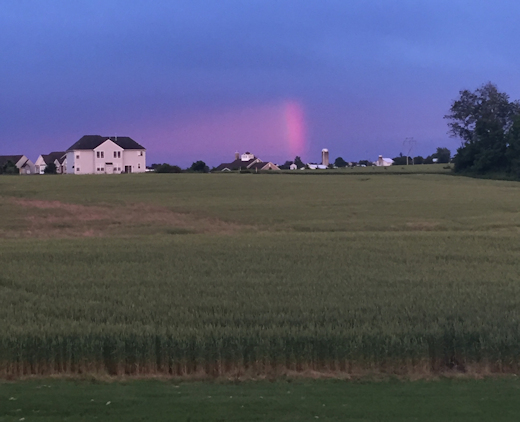
Yes, this *is* a rainbow--a red rainbow spoke.
What made it red? Red was only color available. All of the other colors of the rainbow had been scattered away by air molecules and dust particles in front of the low-hanging sun. Sunset rainbows are often red like this.
Normally, red rainbows form a complete arc. This one, however, was interrupted by clouds. Shadows of clouds near the setting sun stretched across the sky, extinguishing most of the rainbow. Only a single almost-horizontal spoke remained. Weird, indeed. Realtime Space Weather Photo Gallery FATHER'S DAY SPECIAL: What do you get for the Dad who has everything? He probably doesn't have this: A 3D Moon globe laser-etched inside a crystal cube. And, oh yes, it has been to the edge of space: 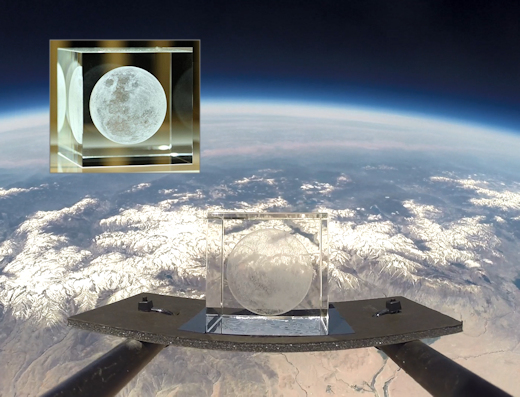
The students of Earth to Sky Calculus flew a payload-full of these unique cubes to the stratosphere on June 3rd. You can have one for $149.95. They're selling them as a fund-raiser for their cosmic ray ballooning program. Each Moon-cube comes with a unique gift card showing the item floating at the top of Earth's atmosphere. The interior of the card tells the story of the flight and confirms that this gift has been to the edge of space and back again. Dad-satisfaction guaranteed. Far Out Gifts: Earth to Sky Store
All proceeds support hands-on STEM education
WHAT IS THE REGENER-PFOTZER MAXIMUM? About once a week, Spaceweather.com and the students of Earth to Sky Calculus launch a helium balloon with radiation sensors to the stratosphere over California. This is a unique monitoring program aimed at tracking the cosmic ray situation in Earth's atmosphere. During each flight, our balloon passes through something called the Regener-Pfotzer Maximum, a layer of peak radiation about 20 km above Earth's surface. This plot of radiation vs. time taken during a typical balloon flight illustrates the peak. 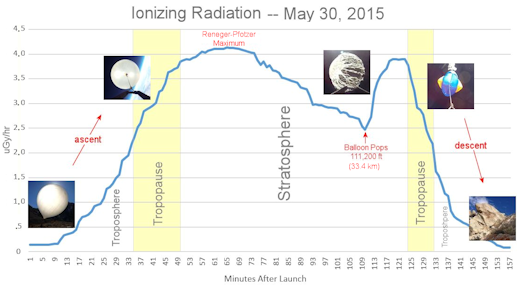
Ref: Phillips, T., et al. (2016), Space Weather Ballooning, Space Weather, 14, 697–703, doi: 10.1002/2016SW001410.
What is this peak? To understand it, let us begin in deep space. Cosmic rays are, essentially, the subatomic debris of dying stars, accelerated to nearly light speed by supernova explosions. They travel across space and approach Earth from all directions, peppering our planet 24/7. When cosmic rays crash into Earth's atmosphere, they produce a spray of secondary particles and photons that is most intense at the entrance to the stratosphere. Physicists Eric Regener and Georg Pfotzer discovered the maximum using balloons in the 1930s and it is what we are measuring today.
In some ways, secondary cosmic rays are like froth on the ocean. By watching the froth, you can learn a lot about the underlying water. Likewise, by watching secondary cosmic rays, we learn a lot about primary cosmic rays hitting the top of the atmosphere. Indeed, our balloon measurements have recently confirmed what NASA spacecraft are finding: The cosmic ray situation is worsening. 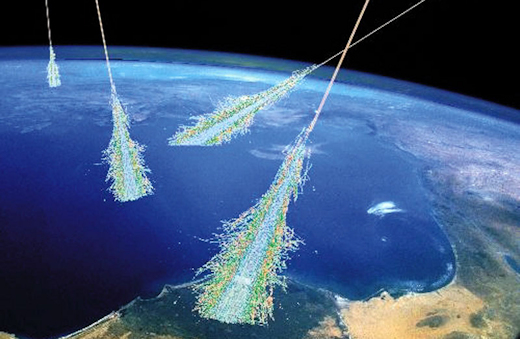
For many years, the Regener-Pfotzer Maximum was called, simply, the "Pfotzer Maximum." Regener's name is less recognized by present-day physicists largely because in 1937 he was forced to take early retirement by National Socialists as his wife had Jewish ancestors. This interesting story weaving science, politics, and human nature has recently been told by historians of science P. Carlson and A. A. Watson. Ref: Hist. Geo Space. Sci., 5, 175-182, 2014.
Technical note: The radiation sensors onboard our helium balloons detect X-rays and gamma-rays in the energy range 10 keV to 20 MeV. These energies span the range of medical X-ray machines and airport security scanners. Realtime Space Weather Photo Gallery
Realtime Aurora Photo Gallery Every night, a network of NASA all-sky cameras scans the skies above the United States for meteoritic fireballs. Automated software maintained by NASA's Meteoroid Environment Office calculates their orbits, velocity, penetration depth in Earth's atmosphere and many other characteristics. Daily results are presented here on Spaceweather.com. On Jun. 7, 2018, the network reported 20 fireballs.
(19 sporadics, 1 Northern June Aquilid)  In this diagram of the inner solar system, all of the fireball orbits intersect at a single point--Earth. The orbits are color-coded by velocity, from slow (red) to fast (blue). [Larger image] [movies] Potentially Hazardous Asteroids ( PHAs) are space rocks larger than approximately 100m that can come closer to Earth than 0.05 AU. None of the known PHAs is on a collision course with our planet, although astronomers are finding new ones all the time. On June 7, 2018 there were 1912 potentially hazardous asteroids.
 | Recent & Upcoming Earth-asteroid encounters: | Asteroid | Date(UT) | Miss Distance | Velocity (km/s) | Diameter (m) | | 2018 LC | 2018-Jun-02 | 17.3 LD | 5.7 | 28 | | 2018 LC1 | 2018-Jun-04 | 10.7 LD | 6.8 | 41 | | 2018 LG1 | 2018-Jun-06 | 19.3 LD | 11.5 | 79 | | 2018 EJ4 | 2018-Jun-10 | 5.6 LD | 6.2 | 195 | | 2015 DP155 | 2018-Jun-11 | 9 LD | 4.4 | 170 | | 2018 LD1 | 2018-Jun-14 | 1.6 LD | 11 | 19 | | 2018 LK | 2018-Jun-15 | 7.7 LD | 12.4 | 154 | | 2018 LF1 | 2018-Jun-16 | 15.7 LD | 14 | 44 | | 2018 KC3 | 2018-Jun-19 | 14.6 LD | 8.9 | 90 | | 2017 YE5 | 2018-Jun-21 | 15.6 LD | 15.5 | 513 | | 467309 | 2018-Jun-23 | 17.9 LD | 14 | 355 | | 441987 | 2018-Jun-24 | 7.3 LD | 12.6 | 178 | | 2018 LJ1 | 2018-Jul-01 | 13.9 LD | 2.6 | 17 | Notes: LD means "Lunar Distance." 1 LD = 384,401 km, the distance between Earth and the Moon. 1 LD also equals 0.00256 AU. MAG is the visual magnitude of the asteroid on the date of closest approach. | | Cosmic Rays in the Atmosphere |
Readers, thank you for your patience while we continue to develop this new section of Spaceweather.com. We've been working to streamline our data reduction, allowing us to post results from balloon flights much more rapidly, and we have developed a new data product, shown here: 
This plot displays radiation measurements not only in the stratosphere, but also at aviation altitudes. Dose rates are expessed as multiples of sea level. For instance, we see that boarding a plane that flies at 25,000 feet exposes passengers to dose rates ~10x higher than sea level. At 40,000 feet, the multiplier is closer to 50x. These measurements are made by our usual cosmic ray payload as it passes through aviation altitudes en route to the stratosphere over California. What is this all about? Approximately once a week, Spaceweather.com and the students of Earth to Sky Calculus fly space weather balloons to the stratosphere over California. These balloons are equipped with radiation sensors that detect cosmic rays, a surprisingly "down to Earth" form of space weather. Cosmic rays can seed clouds, trigger lightning, and penetrate commercial airplanes. Furthermore, there are studies ( #1, #2, #3, #4) linking cosmic rays with cardiac arrhythmias and sudden cardiac death in the general population. Our latest measurements show that cosmic rays are intensifying, with an increase of more than 13% since 2015: 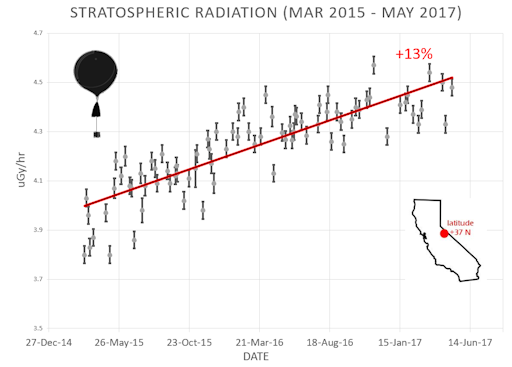
Why are cosmic rays intensifying? The main reason is the sun. Solar storm clouds such as coronal mass ejections (CMEs) sweep aside cosmic rays when they pass by Earth. During Solar Maximum, CMEs are abundant and cosmic rays are held at bay. Now, however, the solar cycle is swinging toward Solar Minimum, allowing cosmic rays to return. Another reason could be the weakening of Earth's magnetic field, which helps protect us from deep-space radiation. The radiation sensors onboard our helium balloons detect X-rays and gamma-rays in the energy range 10 keV to 20 MeV. These energies span the range of medical X-ray machines and airport security scanners. The data points in the graph above correspond to the peak of the Reneger-Pfotzer maximum, which lies about 67,000 feet above central California. When cosmic rays crash into Earth's atmosphere, they produce a spray of secondary particles that is most intense at the entrance to the stratosphere. Physicists Eric Reneger and Georg Pfotzer discovered the maximum using balloons in the 1930s and it is what we are measuring today. | | The official U.S. government space weather bureau | | | The first place to look for information about sundogs, pillars, rainbows and related phenomena. | | | Researchers call it a "Hubble for the sun." SDO is the most advanced solar observatory ever. | | | 3D views of the sun from NASA's Solar and Terrestrial Relations Observatory | | | Realtime and archival images of the Sun from SOHO. | | | from the NOAA Space Environment Center | | | fun to read, but should be taken with a grain of salt! Forecasts looking ahead more than a few days are often wrong. | | | from the NOAA Space Environment Center | | | the underlying science of space weather |  | Reviews here can help you to pick up best memory foam mattresses. | | | These links help Spaceweather.com stay online. Thank you to our supporters! | | | | | | | | |  | |  |   | ©2017 Spaceweather.com. All rights reserved. This site is penned daily by Dr. Tony Phillips. | |

